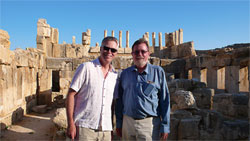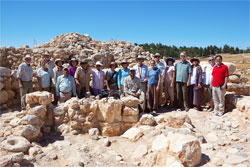Weekly Reports from Jordan
Choose Year: or Choose week
University Administrators Discovering `Umayri
By Douglas Clark
Photos by Jillian Logee & Randal Wisbey
Several years ago the `Umayri team hosted a visit by presidents and vice presidents of institutions which formed the consortium we call the Madaba Plains Project-`Umayri (madabaplains.org/umayri). It was intended to bring academic leaders of our supportive universities to Jordan for an immersive experience, focused on the project to which their institutions were contributing financial and human resources. Current members include: La Sierra University as primary sponsor, in consortium with the School of Architecture at Andrews University (Berrien Springs, MI), Canadian University College (Lacombe, AB, Canada), Mount Royal University (Calgary, AB, Canada), Pacific Union College (Angwin, CA), and Walla Walla University (Walla Walla, WA).
The 2014 season saw the second such visit, this time involving the following:
Dr. Randal and Deanna Wisbey, president of La Sierra University, Riverside, CA
Dr. Steve and Carol Pawluk, provost of La Sierra University
Dr. Nancy Lecourt, vice president for academic administration at Pacific Union College, Angwin, CA
Dr. Mark and Kris Haynal, president of Canadian University College, Lacombe, AB, Canada
They all arrived on Tuesday, 8 July, some from Tel Aviv, Israel, having experienced the beginning of the current crushing spasm of violence convulsing the region, others directly from North America.
 For two days they were shepherded around central and northern Jordan by Lawrence Geraty, founding director of MPP-`Umayri. They visited places like Mount Nebo, Madaba with its famous sixth-century mosaic map of the Holy Land, Dhiban (original location of the Moabite Stone), Umm Ar-Rasas with its spectacular church mosaics, including those in Saint Stephen’s Church from the 9th century AC, the Roman cities of Jarash and Gadara, Pella in the Jordan Valley, and Iraq Al-Amir, location of an amazing fortified palace from a couple centuries BC as well as the “Tobias” caves.
For two days they were shepherded around central and northern Jordan by Lawrence Geraty, founding director of MPP-`Umayri. They visited places like Mount Nebo, Madaba with its famous sixth-century mosaic map of the Holy Land, Dhiban (original location of the Moabite Stone), Umm Ar-Rasas with its spectacular church mosaics, including those in Saint Stephen’s Church from the 9th century AC, the Roman cities of Jarash and Gadara, Pella in the Jordan Valley, and Iraq Al-Amir, location of an amazing fortified palace from a couple centuries BC as well as the “Tobias” caves.
 Friday brought them to Tall al-`Umayri and we almost succeeded in nudging them into the dust and glory of excavation squares. Seeing the actual work on site, and sensing the research design and objectives of the project contributed not only to a better understanding of the project they all support, but to an engaging attachment to our shared endeavors in Jordan. A visit to the Amman Training College (part of the United Nations Relief and Works Agency infrastructure for Palestinians) also provided an opportunity for administrators to experience our “digs” as well as the major recording processes that make up a digital, almost paperless operation in the best tradition of state-of-the-art technologies and practices, including the use of iPads and iPods for data retrieval, an interactive online dig manual, Structure From Motion photography to create daily 3D images of our work, a UAV (octicopter) for 3D still and video recordings of the site and various parts of it.
Friday brought them to Tall al-`Umayri and we almost succeeded in nudging them into the dust and glory of excavation squares. Seeing the actual work on site, and sensing the research design and objectives of the project contributed not only to a better understanding of the project they all support, but to an engaging attachment to our shared endeavors in Jordan. A visit to the Amman Training College (part of the United Nations Relief and Works Agency infrastructure for Palestinians) also provided an opportunity for administrators to experience our “digs” as well as the major recording processes that make up a digital, almost paperless operation in the best tradition of state-of-the-art technologies and practices, including the use of iPads and iPods for data retrieval, an interactive online dig manual, Structure From Motion photography to create daily 3D images of our work, a UAV (octicopter) for 3D still and video recordings of the site and various parts of it.
Friday afternoon through Sunday afternoon found the administrators, along with nearly the entire excavation team, at the ancient site of Petra, one of the seven wonders of the world. On foot, on donkeys, on camels, in horse-drawn carts, everyone traversed to various parts of Petra to capture the wonder of this “rose-red city, half as old as time” (John Burgon, 1845).
Monday was also a full day, some of the afternoon spent in the downtown Amman Suq or vast market place, following lunch at Wild Jordan near Rainbow Street in central, downtown Amman. The morning was occupied by visits to ACOR (the American Center of Oriental Research, our academic home away from home) and the new (and fabulous) Jordan Museum. Following the museum tour, the administrators joined me and several members of the Department of Antiquities of Jordan, museum personnel, other archaeologists, and Jordanian friends of archaeology, for a follow-up meeting from one held in January on how to save Tall al-`Umayri from land development and the loss of its cultural heritage (for reports on the January event, visit this link).
See the next supplement to this summer’s weekly reports ([Re]Discovering the Challenge of `Umayri) for a review of that meeting and of a conversation at `Umayri on Wednesday about the next steps to take in order to secure a future for `Umayri’s considerable cultural wealth over the past 5,000 years.